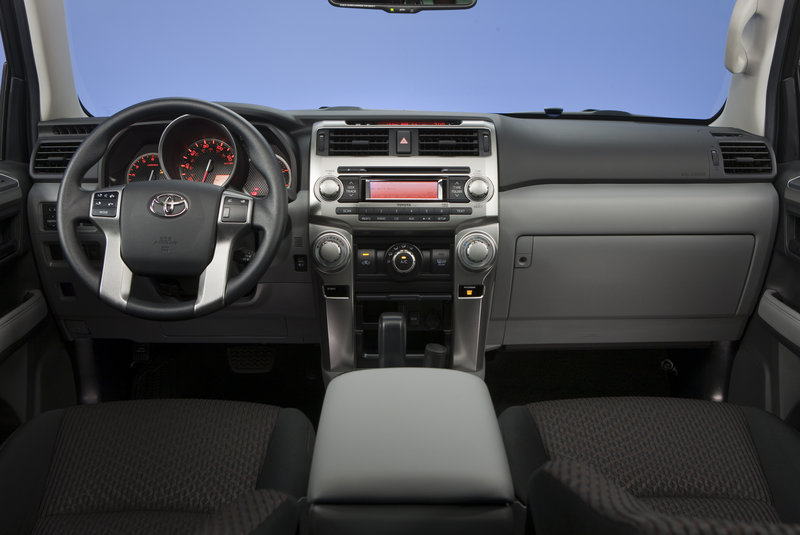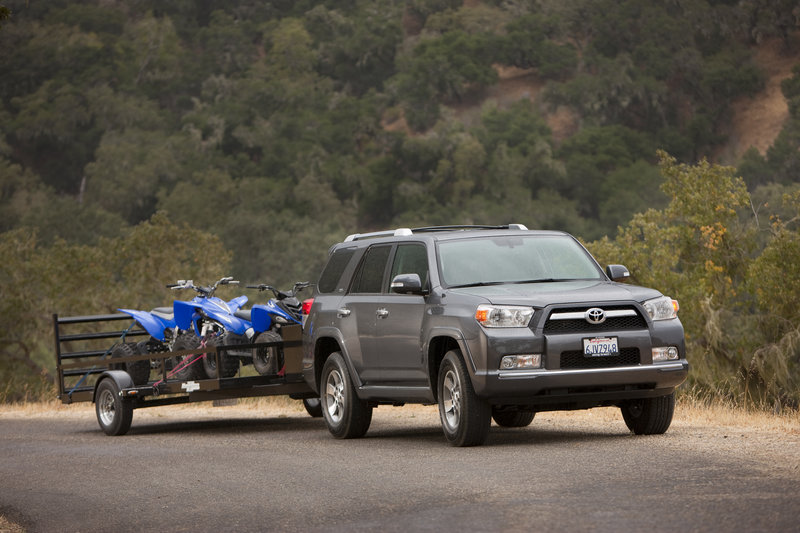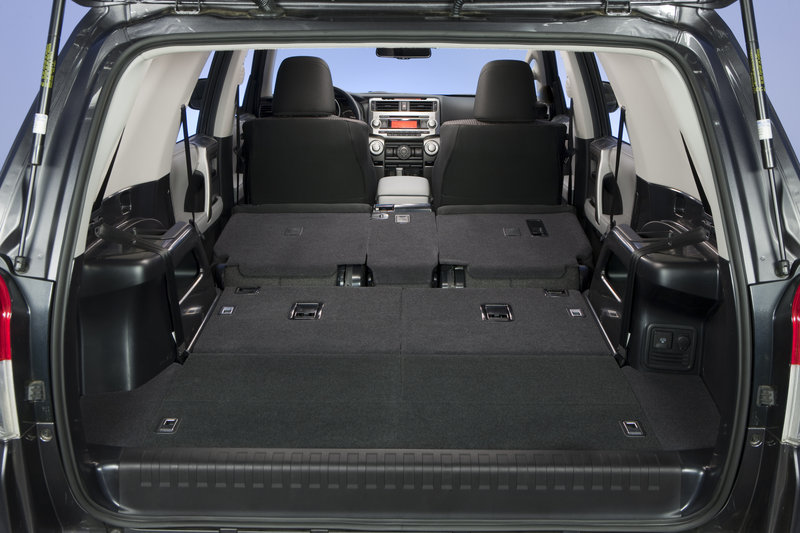– The 2010 Toyota 4Runner SR5 hadn’t been in my possession for even 24 hours before I found myself taking advantage of its capabilities, doing something I’d never have considered doing in a car or most crossovers.
The 4Runner is neither. It is a rugged and robust, midsize, body-on-frame SUV.
It also is one of the most enduring and venerated vehicles in that class. First introduced in 1984, it helped launch the SUV boom of the 1990s. The redesigned 2010 model represents the fifth generation of this Toyota truck.
SUVs such as 4Runner are a dying breed. Some models have disappeared, and sales of those that remain in production have dropped dramatically. There are far fewer on the road than just a few years ago, when it seemed like three out of four vehicles was a conventional SUV.
But the 4Runner remains and remains true to its heritage. It is as rugged and capable as ever, a fact that Toyota stylists seemed to flaunt for the 2010 redesign. Instead of getting sleeker, the 4Runner has muscled up. Instead of the graceful curves and sinuous lines that characterize most crossovers, it has prominent fender flares and other bulges that make it appear anxious for any abuse a driver cares to throw at it.
With its rigid frame and hardy suspension — there are heavy-duty shocks with double-wishbones up front and a four-link, coil-spring rigid rear — 4Runner is much more capable than most vehicles of straying far from paved roads and civilization.
It didn’t take long before I capitalized on those capabilities. Approaching a traffic light, I found myself in a right lane separated from the left by one of those small concrete berms whose purpose is often as much a nuisance as a mystery.
Since there were no other vehicles in sight and a left turn at the intersection would save me about a mile of circuitous driving, I guided the4Runner up and over the berm.
In truth, the hurdle was less formidable than some unpaved driveways. The berm was low enough to make some curbs seem like Mount Everest by comparison.
But the sense of satisfaction I got from crossing it in the 4Runner was incomparable. I had defied “the man” and stood up for the downtrodden by overcoming one of society’s injustices. I’d righted a wrong, using Toyota’s 4Runner as my weapon.
Of course that’s all a crock, but it made me feel as if I’d at least taken some advantage of what 4Runner does best. With no snow to be found, no trailer to tow and no time to explore unpaved wilderness, that’s the closest I came to doing so.
Other than the time I drove the 4Runner down a rough cobblestone street at 20 mph. I know that doesn’t seem like a big deal but, hey, it’s about 15 mph faster than I would have driven the road in a compact car.
None of this is meant to be facetious. About 15 years ago, I attended a scientific presentation that credited the popularity of SUVs to the feelings of invincibility and unstoppability they give drivers.
When gas prices soared past four bucks a gallon, impracticality overcame unstoppability. Although Toyota did a nice job of boosting fuel economy in the new 4Runner — its 17 city/22 highway is pretty good for a powerful 4×4 truck and significantly better than the 14 city/20 highway of a similarly robust, recently tested Nissan Pathfinder — it’s not as good as most midsize crossovers.
Of course most crossovers lack the 4Runner’s 5,000-pound towing capacity, multi-mode four-wheel drive system that can churn through muck and mud, and automated system that makes it easy to descend safely down steep inclines and prevent backsliding when starting up precarious slopes.
Anyone needing a vehicle with such capabilities will find the 4Runner tough to beat because it deftly blends those qualities with versatility and acceptable day-to-day driving performance.
The test vehicle, in 4Runner’s bread-and-butter SR5 trim, has room enough for five adults and a weekend’s worth of luggage. Its 40/20/40 split folding rear seat provides excellent cargo carrying versatility.
Owners who need to carry more passengers can opt for a third-row seat that folds flat when not needed. Five-passenger 4Runner models can be fitted with an optional ($350) sliding cargo deck intended to ease loading and unloading. Although I hauled nothing heavier than a few grocery bags, the 400-pound capacity deck seems like it has the potential to be a real back-saver.
The 4Runner’s cushy ride was a butt-saver whether I was crossing berms or driving on nicely paved roads or cobblestones. Despite its ruggedness and off-road prowess, the 4Runner is a comfy cruiser.
It also feels controllable and competent in normal driving, its direct and responsive steering a quantum leap beyond what we used to associate with SUVs.
But don’t get the impression that the 4Runner is adept at darting around winding country roads. Despite having good grip in the corners, the 4Runner is a tall, heavy vehicle whose height and weight manifests itself in bounce, body lean and leisurely transitions.
Then again, people don’t buy vehicles such as the 4Runner for spirited driving on lonely back roads. Actually, most consumers don’t buy conventional SUVs at all anymore. But for those who need its toughness, versatility and off-road worthiness, a vehicle like the 4Runner can be indispensable.
Those consumers will find that it also ranks near the head of its shrinking class.
Scott Wasser is executive editor of MaineToday Media. He writes a weekly auto column for the Sunday Telegram and other newspapers. He can be reached at
swasser@pressherald.com.NUTS AND BOLTS
WHAT IS IT? 2010 Toyota 4Runner SR5 V6, a rugged, midsize, conventional SUV.
WHAT’S IT COST? 4Runner is available in SR5, Trail and Limited trim levels with starting prices ranging from $27,500 for a four-cylinder, 2WD SR5 to $39,800 for a 4×4 V6 Limited. Test vehicle was a 4×4 V6 SR5 whose $30,915 starting price climbed to $36,634 with options and delivery fee.
WHAT I LIKED BEST: 4 Runner.s versatility and the feeling of unstoppable ruggedness that comes with driving it.
WHAT I LIKED LEAST: Maneuvering in tight quarters, pushing it on twisting back roads and filling it with fuel.
WHO’S IT FOR? When pump prices reached $4/gallon, people who didn’t really need a big SUV started shedding them. But if you do much towing, hauling or serious off-roading, it’s hard to beat a vehicle such as the 4-Runner.
IMPORTANT NUMBERS: 4.0-liter, 24-valve, V-6 with variable valve timing produces 270 horsepower, 278 pounds feet of torque. 5-speed automatic. 109.8-inch wheelbase. 4,675-pound curb weight. 17city/22 highway mpg. 9.6 inches ground clearance. 47.2/89.7 cubic feet cargo space behind 2nd/1st-row seats. 5,000-pound towing capacity. Zero-60 mph in 7.7 seconds (stopwatch).
Send questions/comments to the editors.





Success. Please wait for the page to reload. If the page does not reload within 5 seconds, please refresh the page.
Enter your email and password to access comments.
Hi, to comment on stories you must . This profile is in addition to your subscription and website login.
Already have a commenting profile? .
Invalid username/password.
Please check your email to confirm and complete your registration.
Only subscribers are eligible to post comments. Please subscribe or login first for digital access. Here’s why.
Use the form below to reset your password. When you've submitted your account email, we will send an email with a reset code.